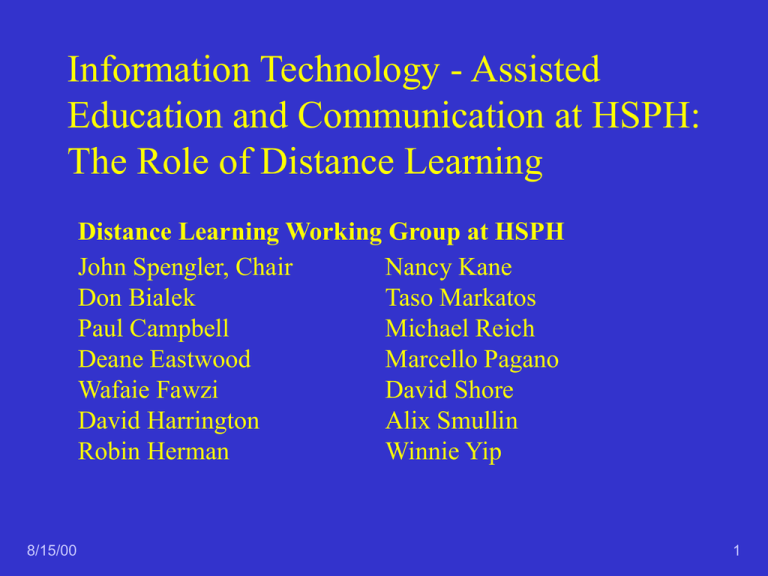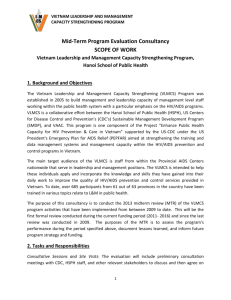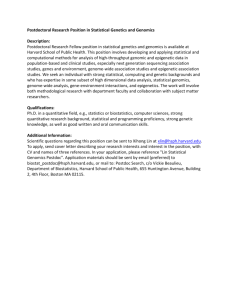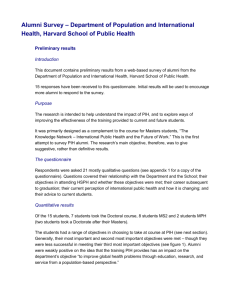DL Report-Aug 15-Color - Harvard Wiki
advertisement

Information Technology - Assisted Education and Communication at HSPH: The Role of Distance Learning Distance Learning Working Group at HSPH John Spengler, Chair Nancy Kane Don Bialek Taso Markatos Paul Campbell Michael Reich Deane Eastwood Marcello Pagano Wafaie Fawzi David Shore David Harrington Alix Smullin Robin Herman Winnie Yip 8/15/00 1 Dean’s Challenge to the Working Group •Why pursue distance learning? •What level of resources should be committed? •What strategies should be advanced? 8/15/00 2 Rationale for DL at HSPH HSPH Education and Communication Mission includes: •Students attending School •Practicing public health professionals •Many other health-related professionals •Alumni •Media •Political Leaders 8/15/00 3 Rationale for DL at HSPH Educational Objectives include: •Improving teaching and teaching facilities •Expand connections to alumni •Enroll more minority students and students from developing world 8/15/00 4 Rationale for DL at HSPH Communication Objectives include: •Influencing national and international policy •Creating media-based prevention programs •Expanding discussion and debate •Broadening participation in community-based public health practice 8/15/00 5 Rationale for DL at HSPH Competition is Hard at Work: •Johns Hopkins offers degrees and executive training •London School of Hygiene and Tropical Medicine has ~400 DL students from 66 countries •University of North Carolina is leading an attempt to form a DL consortium for public health education through APHA 8/15/00 6 Current Capacity at HSPH HSPH lags behind KSG, GSD, HMS, HBS, and HLS in its capacity for DL course and seminar production as well as facilitation of two-way instructional communication 8/15/00 7 Current Capacity at HSPH Available equipment and technical expertise in underutilized: •Only 100 web accounts have been authored on the HSPH server. •CourseInfo 3.0 by Blackboard.com is available with training and assistance but only 63 out of ~300 courses used the system in the 1999/2000 academic year (http://www.hsph.harvard.edu/courses). •Real Networks’ Basic Server is available for short audio/video transmissions. Only 100 streams per week, but substantial upgrades are needed to videostream a full class and course. Visit http://www.hsph.harvard.edu/video for demonstrations. 8/15/00 8 HSPH Faculty Interest in IT •Increase teaching effectiveness in the classroom •Interest high in currently available tools (e.g., “Blackboard” course organizer) •Available systems under-utilized: 33% use Blackboard for courses >20% use Internet communications 10% use teleconferencing •Reservations about expanding to on-line teaching •Cautious about joint ventures with commercial companies 8/15/00 9 Choosing Our DL Future at HSPH Matriculating Courses Supporting HSPH collaborating centers Special outreach programs Continuing Professional Ed Collaborations with World Bank et al. Advance Technical Training for Alumni MPH Track 2 Other degree programs DL Programs Production and Broadcasting Capacity: •satellite uplinks •conferencing Classroom Upgrades: •recording •IT connections 8/15/00 Basic Services: •course web support 10 Guide to HSPH DL Strategies •Possible DL Programs •Required HSPH Infrastructure •Strategies/Recommendations for an IT/DL transition •Issues to be Resolved •Recommendations: Conclusions or Beginnings 8/15/00 11 HSPH DL Activities Compatible with Mission •Track 2: –MPH with distance learning component •Training Centers: –international partnerships targeting region-specific needs •Professional Outreach –rural public health agencies –alumni –CPPE certificate program •Enhanced HSPH courses/programs –matriculation of required courses –visiting lecturers/virtual field trips 8/15/00 12 Track 2: MPH-DL Component •4-Week Session at HSPH during the Summer or Intercession: –to introduce a course/week –meet faculty and TA’s –associate with fellow students •Continue courses over a year with: –chat lines, e-mail –net meetings, web cameras –CD or web server providing course content •Hold several teleconferences and/or web-camera meetings throughout course to track performance orally and with test and reports 8/15/00 13 Track 2: MPH-DL Component •4-Week Session at HSPH during the Summer or Intercession: –to introduce a course/week –meet faculty and TA’s –associate with fellow students •Continue courses over a year with collaborative tools, such as: –chat lines, e-mail –net meetings, web cameras –CD or web server providing course content •Hold several teleconferences and/or web-camera meetings throughout course to track performance orally and with test and reports 8/15/00 14 Track 2: MPH-DL Component •4-Week Session at HSPH during the Summer or Intercession: –to introduce a course/week –meet faculty and TA’s –associate with fellow students •Continue courses over a year with: –chat lines, e-mail –net meetings, web cameras –CD or web server providing course content •Hold several teleconferences and/or web-camera meetings throughout course to track performance orally and with test and reports 8/15/00 15 Milestones for Track 2 MPH •Gain approval of MPH director and faculty. •Identify faculty committed to developing DL course components •Digitally record lectures 2000-2001 •Assign in-house advance TA/web masters or hire others (eCollege/Blackboard) to develop customized course materials •Advertise program for limited involvement (~50) starting summer 2001 8/15/00 16 International Centers-Supported with DL Content & Communication Technology •Establish international centers in cooperation with prominent universities. •Develop training curriculum •Establish IT communication capacity 8/15/00 17 Possible HSPH Centers Athens Center for Environmental & Occupational Health 8/15/00 Tanzania Center for Maternal & Child Health 18 Possible HSPH Center Hong Kong Center for Human Development 8/15/00 19 Professional Outreach Initiatives Level 1: Advanced professional training for alumni ranging from web site research news to short tutorials Level 2: Continuing professional education structured around certificate programs Level 3: Partnerships with public agencies to enhance training and delivery of services 8/15/00 20 Professional Outreach Initiatives Level 2: Center for Continuing Professional Education activities and a Certificate Program •Capture-Release model using DL to enhance the learning experience •Certificate Program –cluster of course-related to key competence –DL to assist with home/office learning and testing 8/15/00 21 Professional Outreach Initiatives Level 2: Center for Continuing Professional Education activities and a Certificate Program •Capture-Release model using DL to enhance the learning experience •Certificate Programs –cluster of course-related to key competence –DL to assist with home/office learning and testing 8/15/00 22 Professional Outreach Initiatives Level 3: Reaching Underserved Public Health Related Communities •Rural and city health programs needing public health training •Educational content to school-based health nurses •Health home training for public housing authorities, tribal nations, housing inspectors, and other social service professionals 8/15/00 23 Advancing the DL Transition •Upgrading School facilities and staff •Collaboration with other schools •Access to the Provost’s Fund for Innovation •Administrative leadership to facilitate innovative academic programs 8/15/00 24 Advancing the DL Transition Upgrade School Facilities: •Outfit all auditoriums and large classrooms (including Landmark) with built-in computers and projection system (fix lighting) •Auditoriums need to be upgraded to include projection system, better lighting, and laptop plug-ins at each seat •Install video-conferencing capabilities in every classroom and multipoint conferencing throughout HSPH buildings. 8/15/00 25 Advancing the DL Transition Upgrade the School DL Staff •1 Instructional Technologist •1 Video-Production/Teleconferencing Technologist as required to support production and dissemination of DL courses •2 FTE Junior Technical Staff •Provide advanced training for faculty and teaching assistants providing web-based and teleconferencing support to courses 8/15/00 26 Advancing the DL Transition Collaborate with Others: •Participate in the new University Consortium on DL •Obtain access to streaming video production facility •Ensure that the University will provide HSPH with Internet II access •Establish electronic publishing partnerships with the private sector and/or Harvard University Press 8/15/00 27 Advancing the DL Transition Collaborate with Others: •Participate in the new University Consortium on DL •Obtain access to streaming video production facility •Ensure that the University will provide HSPH with Internet II access •Establish electronic publishing partnerships with the private sector and/or Harvard University Press 8/15/00 28 Advancing the DL Transition Access to the Provost’ Funds for Innovation: •$6-7 million is available to cost-share IT innovation in teaching and training through the office of the Provost •The School should provide matching funds to encourage innovating faculty 8/15/00 29 Advancing the DL Transition Administrative Leadership: •Embrace a DL transition strategy •Appoint DL/IT Program Coordinator to liaison with faculty and other schools •Commit to fundraising and financial support 8/15/00 30 DL Strategy for HSPH Near Term (months): •Use summer programs and CCPE revenues to develop DL moduals for: –matriculating students –certification program -online “anytime” courses •Commit to infrastructure and tech support upgrade program over 3-5 years •Partner with publishing company for electronic text •Cost share Provost’s DL innovation proposals from School 8/15/00 31 DL Strategy for HSPH Mid Term (next academic year) •Appoint DL/IT Program Coordinator •Gain faculty and committee clearances for DL courses •With faculty ad hoc advisory group decide if the HSPH will undertake a MPH DL program or not •Establish a working group on international training and research centers 8/15/00 32 DL Strategy for HSPH Long Term •Develop full DL ready courses for selected academic program •Establish international training centers –collaborating with institutions –with World Bank international centers 8/15/00 33 Expense Estimates for DL Infrastructure1: $500,000 over 3-5 years $50,000 annual maintenance, replacement, improvements Technical Staff2: $250,000 per year DL Course Production3: $25,000 to $50,000 per course Interactive Textbook4: $100,000 to $250,000 Cost-Sharing Innovative Proposals5: $450,000 over 3 years (3 x $150,000) Communication Costs6: Internet Services/year, $100,000 $100/hr x 1000 hrs/year of full conferencing services 8/15/00 34 Revenue Estimates for DL Matriculating Courses1: 300 Students x $100/course $30,000/year Continuing Professional Education (CCPE)2: 500 participants x $500/course $250,000/year MPH Track 2 Program3: 200 students x $10,000/year $2,000,000/year Advanced Professional Part-Time Degrees4: 100 students x $10,000/year $1,000,000/year Professional Briefings 8/15/00 Free 35 Challenges to Our DL Future •Partnerships with the private sector or other organizations •Quality control of course content and degree granting •Content ownership •Faculty motivation •Marketing of IT-assisted courses •Upgrading technical facilities 8/15/00 36 Challenges to Our DL Future •Partnerships with the private sector or other organizations •Quality control of course content and degree granting •Content ownership •Faculty motivation •Marketing of IT-assisted courses •Upgrading technical facilities 8/15/00 37 Challenges to Our DL Future •Partnerships with the private sector or other organizations •Quality control of course content and degree granting •Content ownership •Faculty motivation •Marketing of IT-assisted courses •Upgrading technical facilities 8/15/00 38 Challenges to our DL Future •Partnerships with the private sector or other organizations •Quality control of course content and degree granting •Content ownership •Faculty motivation •Marketing of IT-assisted courses •Upgrading technical facilities 8/15/00 39 CONCLUSION OR BEGINNING? •The School will be at a disadvantage if it does not provide ITassisted learning for current programs. •Upgraded IT capabilities facilitate advancing DL. •The School’s near-term DL target audience is the working professional. CCPE should aggressively pursue that market generating spin-off products for alumni, matriculating students and other programs. •The School’s long-term DL target is the international MPH and MS student with the goal of providing IT-assisted education through collaborating centers. 8/15/00 40




